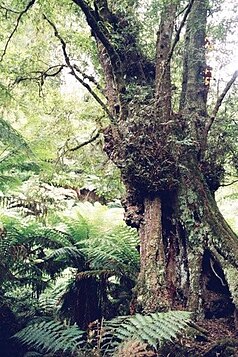Tarra Bulga National Park
| Tarra Bulga National Park | ||
|---|---|---|
| Forest in Tarra Bulga National Park | ||
|
|
||
| Location: | Victoria , Australia | |
| Specialty: | Eucalyptus forest, cold temperate rainforest | |
| Next city: | Balook, Yarram | |
| Surface: | 15.22 km² | |
| Founding: | 1986 | |
| Wooded area near Cyathea Falls | ||
The Tarra Bulga National Park is a national park in the southeast of the Australian state of Victoria , 158 km east of Melbourne and 27 km south of Traralgon in the Strzelecki Mountains . There you can find the last places of the eucalyptus - primary forest , as it once covered the whole region.
history
The area was first declared a Bulga National Park in 1904 , which only covered 20 hectares. In 1909 the Tarra Valley National Park was established in the vicinity . Over the decades, the two parks have been steadily enlarged and finally merged under the current name in 1986.
vegetation
The deeply cut river valleys of the park are dominated by moist sclerophyll forest (mainly mountain ash (Eucalyptus regnans)). The undergrowth consists mostly of blackwood (Acacia melanoxylon), pomaderris (Pomaderris aspera) and tree ferns (Dicksonia antarctica, Cyathea australis). In some spots in the park you can also find cold-temperate rainforest with myrtle beeches (Nothofagus cunninghamii). The heights are covered with low, sparse forest, mostly eucalypti of the species P eppermint and Gum .
Attractions
In the park there is a large suspension bridge over the valley and many hiking trails. There you can get an impression of what the forest looked like in large parts of today's Victoria.
Web links
Individual evidence
- ^ Steve Parish: Australian Touring Atlas located. Steve Parish Publishing Pty. Ltd. Archerfield QLD (2007). ISBN 978174193232-4 . P. 50


